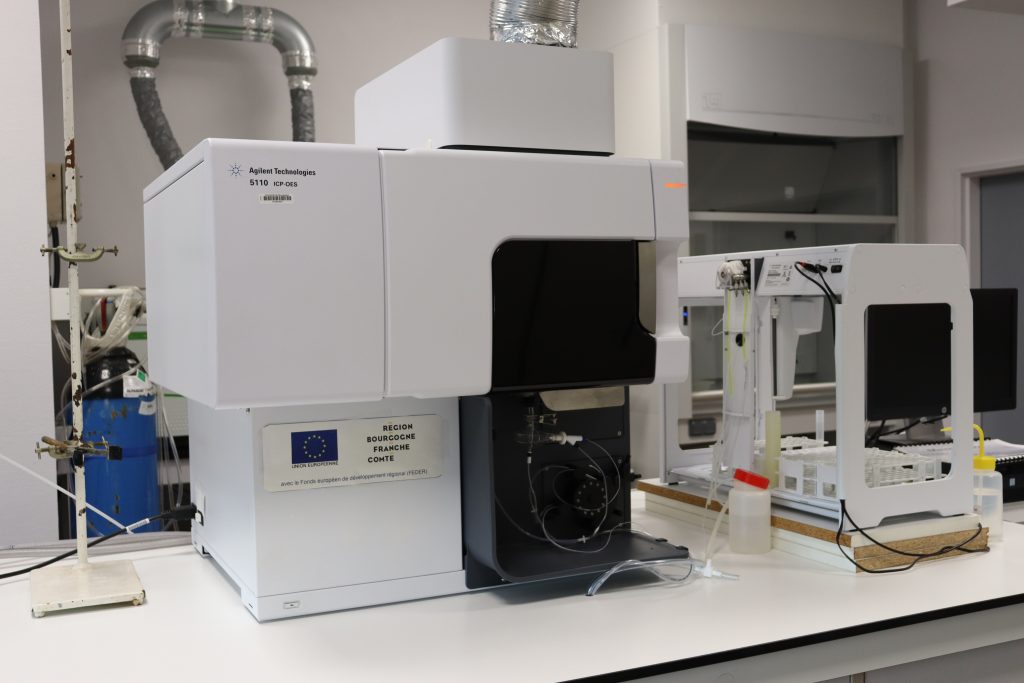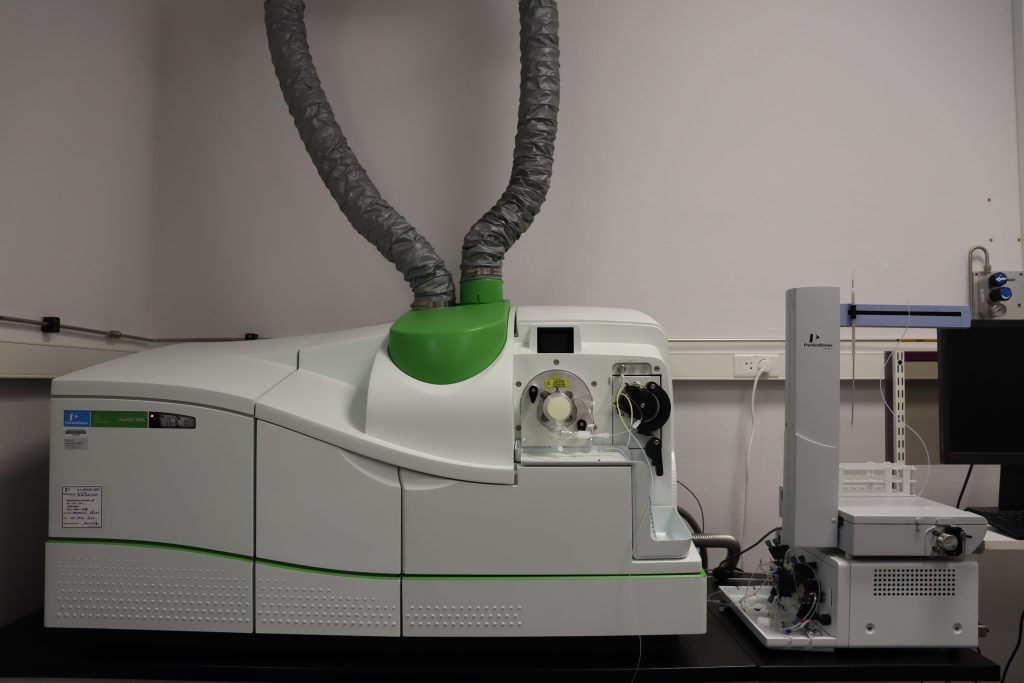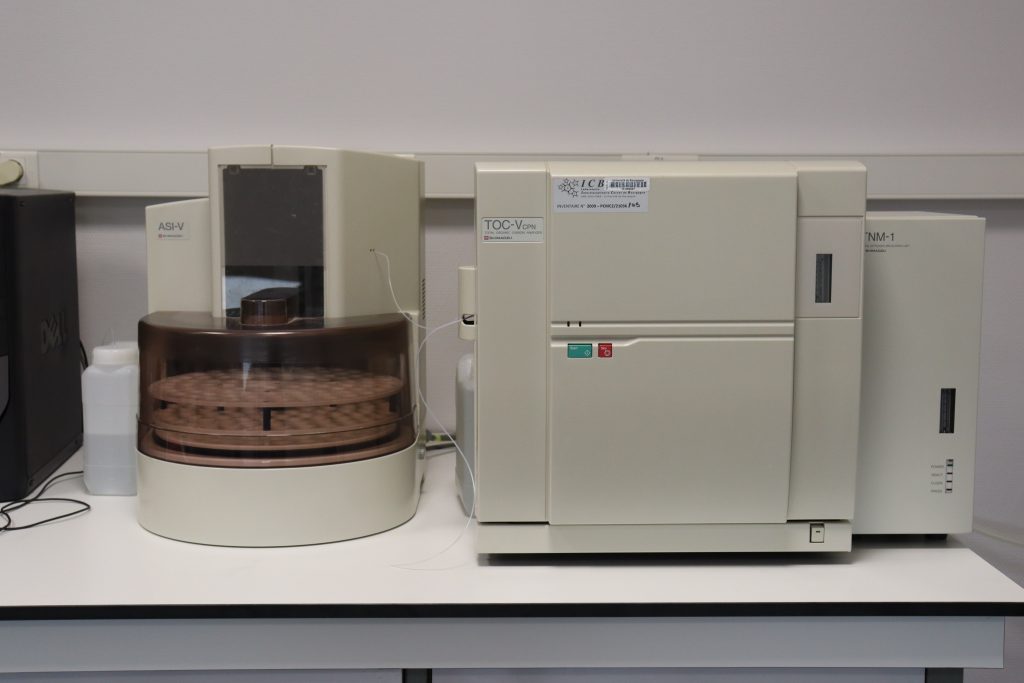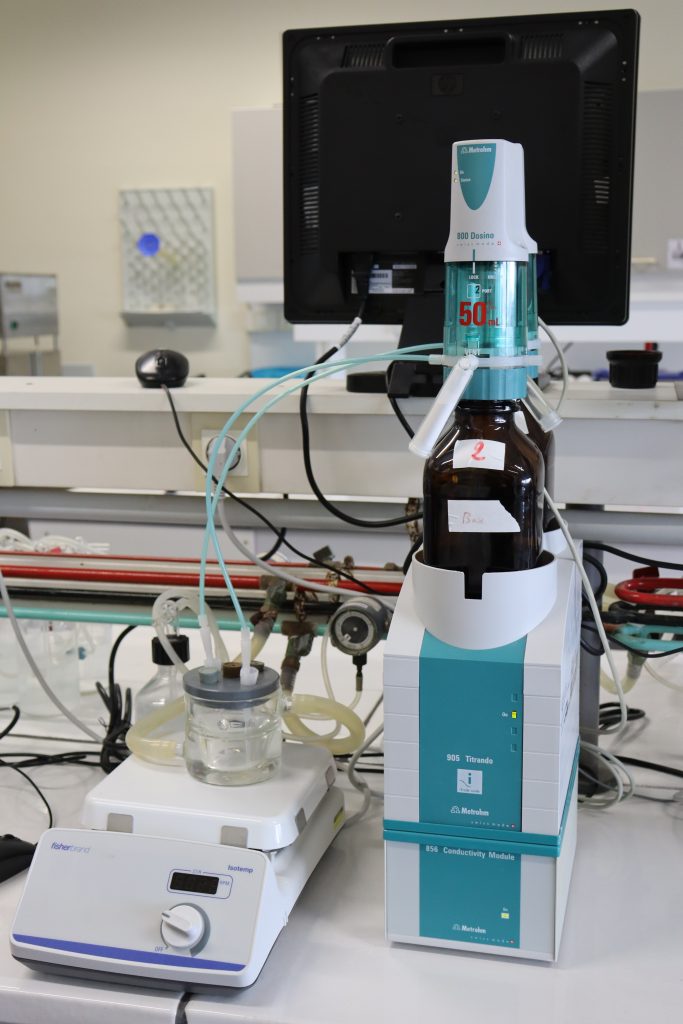
Chemical analysis center
This service makes it possible to carry out physico-chemical analyzes (conductimetry, pH-metry, etc.) as well as elementary analyzes of solutions or solids after their dissolution. Most of the elements of the periodic table are covered over a wide range of concentrations, including trace levels (very low concentration).
Advising and training users on the preparation of samples, the use of instruments as well as the optimization of methods/protocols for the systems to be analyzed are also the missions of the service.
The CAC thus provides a set of services to the scientific community and to the industrial world in their analytical needs.
Analytical equipment
ICP-OES 5110 AGILENT TECHNOLOGIES
Optical emission spectrometry linked to an inductively coupled plasma makes it possible to analyze several major elements present in solution.
Principle: The principle of this technique is based on the ionization of microdroplets of samples in an argon plasma (6000-8000°C). The plasma acts as an energy source to dissociate, excite and ionize the sample. When the atom is excited, an electron changes orbital then the atom de-excites and the electron falls back to its fundamental level by emitting a photon characterized by a specific wavelength of the element. The emitted photon is then detected by a CCD detector. The intensity of the signal is proportional to the concentration of the analyzed element.
Limits of detection: up to 200 ppb, determination of DL depending on matrices and samples to be analyzed
ICP-MS NexION 300X PERKINELMER
Mass spectrometry coupled with an inductive plasma makes it possible to quantify elements by measuring the intensity of the mass-to-charge ratio of atoms constituting a material.
Principle: The principle of this technique is based on the ionization of microdroplets of samples in an argon plasma (6000-8000°C). The plasma acts as an energy source to dissociate, excite and ionize the sample. Atoms that are usually ionized once are then separated in the mass filtration system. The mass filtration system consists of metal bars on which potentials are applied. Elements are detected based on their mass and charge.
Limits of Detection: Up to ppt, determination of LoD based on matrices and samples to be analyzed
SHIMADZU TOC-VCPN Total Organic Carbon Analyzer
The organic carbon analyzer allows the analysis of natural water and industrial effluent. This instrument can measure total carbon (TC), inorganic carbon (IC), total organic carbon (TOC) and nitrogen (TN).
Principle for carbon analysis: The sample is injected into a quartz tube composed of a platinum catalyst. The carbon is converted into CO2 by combustion at 680°C at the platinum catalyst. The CO2 produced is then transported by a carrier gas (Air) to the Non-Dispersive Infrared (NDIR) detector. The NDIR emits an analog detection signal which forms a peak. The peak area is measured. The area of the peak is proportional to the concentration of TC in the sample.
Principle for nitrogen analysis: The sample is injected into a combustion tube (furnace at 720°C), the TN contained in the sample decomposes into nitric oxide. The gas then enters a chemiluminescent gas analyzer, where nitric oxide is detected. The detection signal from the chemiluminescent gas analyzer generates a peak and the concentration of TN in the sample is measured.
In TN analysis, the state (crystalline state) in which TN exists in the sample affects the detection rate of TN. Nitrogen contained in nitrates, nitrites, ammonia and most other organic nitrogen compounds have high detection rates. In contrast, some organic nitrogen compounds (such as hydrazines, pyrazolones, and nitrogen compounds) have detection rates ranging from 10% to 60%, depending on the concentration.
Detection limits: 50 ppb in TC, 4 ppb in IC and 0.03 ppm in N.
Titrator 905 Titrando and 856 Conductivity Module METROHM
Principle: The 905 Titrando allows various potentiometric assays to be performed with various matrices. The 856 conductivity module can be coupled to the titrator. It allows to measure the conductivity and the temperature of the analyzed solution
- kc_data:
- a:8:{i:0;s:0:"";s:4:"mode";s:2:"kc";s:3:"css";s:0:"";s:9:"max_width";s:0:"";s:7:"classes";s:0:"";s:9:"thumbnail";s:0:"";s:9:"collapsed";s:0:"";s:9:"optimized";s:0:"";}
- kc_raw_content:
- [kc_row use_container="yes" _id="453531"][kc_column width="12/12" video_mute="no" _id="634037"][kc_single_image image_size="full" _id="952275" image_source="media_library" image="38402"][/kc_column][/kc_row][kc_row use_container="yes" _id="393421"][kc_column width="12/12" video_mute="no" _id="503168"][kc_spacing height="40px" _id="856998"][kc_column_text _id="261208"]
Chemical analysis center
[/kc_column_text][kc_spacing height="20px" _id="810073"][/kc_column][/kc_row][kc_row use_container="yes" _id="4508"][kc_column width="56.41%" _id="443127"][kc_column_text _id="787768"]The chemical analysis center (CAC) is attached to the INTERFACES Department of the ICB laboratory. The CAC equipment are detailed below.This service makes it possible to carry out physico-chemical analyzes (conductimetry, pH-metry, etc.) as well as elementary analyzes of solutions or solids after their dissolution. Most of the elements of the periodic table are covered over a wide range of concentrations, including trace levels (very low concentration).
Advising and training users on the preparation of samples, the use of instruments as well as the optimization of methods/protocols for the systems to be analyzed are also the missions of the service.
The CAC thus provides a set of services to the scientific community and to the industrial world in their analytical needs.
[/kc_column_text][/kc_column][kc_column width="10.23%" _id="890715"][/kc_column][kc_column width="33.33%" _id="814753"][kc_spacing height="20" _id="987177"][kc_column_text _id="298299"]Anne-Charlotte GUILLET
AI CNRS, Technical Manager
Anne-charlotte.guillet@u-bourgogne.fr
[/kc_column_text][kc_spacing height="20" _id="975198"][kc_column_text _id="176727"]
Phone : 03 80 39 61 44Christophe LABBEZ
Chercheur CNRS, Scientific Manager
christophe.labbez@u-bourgogne.fr
[/kc_column_text][kc_spacing height="40px" _id="418711"][kc_single_image image_size="full" _id="87574" image_source="media_library" image="41813" on_click_action="open_custom_link" custom_link="https://icb.u-bourgogne.fr/wp-content/uploads/2023/11/Fiche-demande-danalyse.pdf||_blank"][/kc_column][/kc_row][kc_row use_container="yes" _id="134368"][kc_column width="12/12" video_mute="no" _id="489982"][kc_spacing height="40px" _id="643002"][kc_column_text _id="563325"]
Phone : 03 80 39 61 76Analytical equipment
[/kc_column_text][/kc_column][/kc_row][kc_row use_container="yes" _id="443637" cols_gap="{`kc-css`:{}}" force="__empty__" animate="fadeInLeft||"][kc_column width="100%" _id="338239"][kc_spacing height="30px" _id="579190"][/kc_column][/kc_row][kc_row use_container="yes" _id="50497" cols_gap="{`kc-css`:{}}" force="__empty__" animate="fadeInLeft||"][kc_column width="49.82%" _id="464672"][kc_column_text _id="373879" css_custom="{`kc-css`:{}}"]ICP-OES 5110 AGILENT TECHNOLOGIES
Optical emission spectrometry linked to an inductively coupled plasma makes it possible to analyze several major elements present in solution.
Principle: The principle of this technique is based on the ionization of microdroplets of samples in an argon plasma (6000-8000°C). The plasma acts as an energy source to dissociate, excite and ionize the sample. When the atom is excited, an electron changes orbital then the atom de-excites and the electron falls back to its fundamental level by emitting a photon characterized by a specific wavelength of the element. The emitted photon is then detected by a CCD detector. The intensity of the signal is proportional to the concentration of the analyzed element.
Limits of detection: up to 200 ppb, determination of DL depending on matrices and samples to be analyzed
[/kc_column_text][/kc_column][kc_column width="9.24%" _id="560321"][/kc_column][kc_column width="40.88%" _id="768106"][kc_single_image image_size="large" _id="959756" image_source="media_library" image="34386" on_click_action="lightbox"][/kc_column][/kc_row][kc_row use_container="yes" _id="357512"][kc_column width="12/12" video_mute="no" _id="726530"][kc_spacing height="40px" _id="244541"][/kc_column][/kc_row][kc_row use_container="yes" _id="25407" cols_gap="{`kc-css`:{}}" force="__empty__" animate="fadeInLeft||"][kc_column width="49.82%" _id="953879"][kc_single_image image_size="large" _id="80333" image_source="media_library" image="34389" on_click_action="lightbox"][/kc_column][kc_column width="9.24%" _id="511647"][/kc_column][kc_column width="40.88%" _id="409943"][kc_column_text _id="474520"]ICP-MS NexION 300X PERKINELMER
Mass spectrometry coupled with an inductive plasma makes it possible to quantify elements by measuring the intensity of the mass-to-charge ratio of atoms constituting a material.
Principle: The principle of this technique is based on the ionization of microdroplets of samples in an argon plasma (6000-8000°C). The plasma acts as an energy source to dissociate, excite and ionize the sample. Atoms that are usually ionized once are then separated in the mass filtration system. The mass filtration system consists of metal bars on which potentials are applied. Elements are detected based on their mass and charge.
Limits of Detection: Up to ppt, determination of LoD based on matrices and samples to be analyzed
[/kc_column_text][/kc_column][/kc_row][kc_row use_container="yes" _id="695981"][kc_column width="12/12" video_mute="no" _id="88128"][kc_spacing height="40px" _id="863034"][/kc_column][/kc_row][kc_row use_container="yes" _id="448883" cols_gap="{`kc-css`:{}}" force="__empty__" animate="fadeInLeft||"][kc_column width="49.82%" _id="85041"][kc_column_text _id="187065"]SHIMADZU TOC-VCPN Total Organic Carbon Analyzer
The organic carbon analyzer allows the analysis of natural water and industrial effluent. This instrument can measure total carbon (TC), inorganic carbon (IC), total organic carbon (TOC) and nitrogen (TN).
Principle for carbon analysis: The sample is injected into a quartz tube composed of a platinum catalyst. The carbon is converted into CO2 by combustion at 680°C at the platinum catalyst. The CO2 produced is then transported by a carrier gas (Air) to the Non-Dispersive Infrared (NDIR) detector. The NDIR emits an analog detection signal which forms a peak. The peak area is measured. The area of the peak is proportional to the concentration of TC in the sample.
Principle for nitrogen analysis: The sample is injected into a combustion tube (furnace at 720°C), the TN contained in the sample decomposes into nitric oxide. The gas then enters a chemiluminescent gas analyzer, where nitric oxide is detected. The detection signal from the chemiluminescent gas analyzer generates a peak and the concentration of TN in the sample is measured.
In TN analysis, the state (crystalline state) in which TN exists in the sample affects the detection rate of TN. Nitrogen contained in nitrates, nitrites, ammonia and most other organic nitrogen compounds have high detection rates. In contrast, some organic nitrogen compounds (such as hydrazines, pyrazolones, and nitrogen compounds) have detection rates ranging from 10% to 60%, depending on the concentration.
Detection limits: 50 ppb in TC, 4 ppb in IC and 0.03 ppm in N.
[/kc_column_text][/kc_column][kc_column width="9.24%" _id="758196"][/kc_column][kc_column width="40.88%" _id="640535"][kc_single_image image_size="large" _id="997559" image_source="media_library" image="34387" on_click_action="lightbox"][/kc_column][/kc_row][kc_row use_container="yes" _id="463359"][kc_column width="12/12" video_mute="no" _id="941150"][kc_spacing height="40px" _id="484740"][/kc_column][/kc_row][kc_row use_container="yes" _id="914747" cols_gap="{`kc-css`:{}}" force="__empty__" animate="fadeInLeft||"][kc_column width="49.82%" _id="414894"][kc_single_image image_size="large" _id="782734" image_source="media_library" image="34384" on_click_action="lightbox"][/kc_column][kc_column width="9.24%" _id="199725"][/kc_column][kc_column width="40.88%" _id="667297"][kc_column_text _id="10984"]Titrator 905 Titrando and 856 Conductivity Module METROHM
Principle: The 905 Titrando allows various potentiometric assays to be performed with various matrices. The 856 conductivity module can be coupled to the titrator. It allows to measure the conductivity and the temperature of the analyzed solution
[/kc_column_text][/kc_column][/kc_row]




